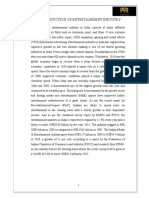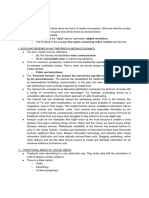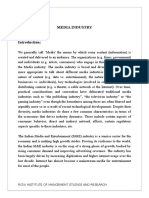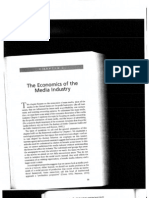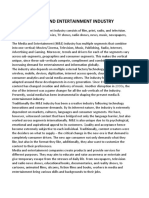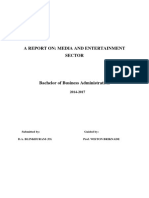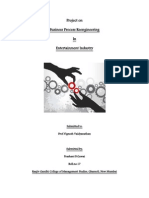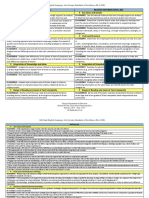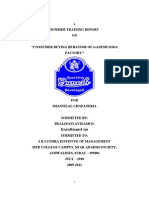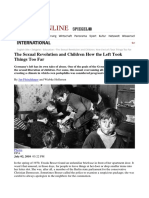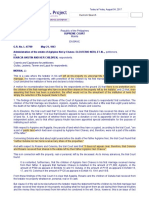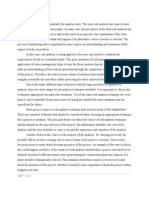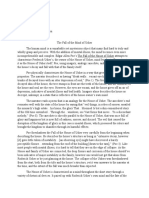Media management is seen as a business administration discipline that identifies and describes
strategic and operational phenomena and problems in the leadership of mediaenterprises. Media
management contains the functions strategic management, procurement management, production
management, organizational management and marketing of media enterprises.
Definition of media management
A uniform definition of the term media management does not yet exist, and the field of media
management in its present form is neither clearly defined nor cohesive. Notwithstanding this fact,
among existing definitions there is a shared base concerning the business administrative character
of media management and the functional understanding of management. In the following a number
of definitions are provided.
Media Management consists of (1) the ability to supervise and motivate employees and (2) the
ability to operate facilities and resources in a cost-effective (profitable) manner.
The core task of media management is to build a bridge between the general theoretical disciplines
of management and the specifities of the media industry.
Media and internet management covers all the goal-oriented activities of planning, organization
and control within the framework of the creation and distribution processes for information or
entertainment content in media enterprises.
Media enterprises and media markets
Media enterprises are strategically organized economic entities whose central work is generating
and marketing of media. The generation of media is the bundling of internally and externally
generated content and its transformation into a medium. The marketing is the direct or
indirect distribution of media. The term media in this connection is restricted to one-to-manycommunication with one sender and a large number of consumers. More precisely, the focus is
on newspapers, magazines, books, music, television, films,internet and games. More details can be
drawn from the graphic illustrating the definition of media enterprises.
�Image shows the definition of media companies.
In order to understand management in media enterprises it is crucial to build a larger picture of the
media marketplace. The characteristics of media markets differ from markets of other economic
sectors in several ways.
One characteristic of media markets is the multidimensional competition. Media enterprises
operate in three different markets. They sell their services in form of content like information and
entertainment, as well as in form of advertising space. These services are offered for different
business markets. The content is offered to the consumer markets which differ depending of the
type of media and the way it is used by consumers. The advertising spaces are traded on
advertisement markets.
The third markets are procurement markets. They are needed as media enterprises generally do
not produce all their offered content themselves but buy service packages of both, information and
entertainment, from procurement markets. For example, authors and artists contracts or license
and copyright deals can be acquired. But procurement markets can turn to business markets if, for
example, complete rights to an event are purchased and then resold by a media enterprise in the
form of secondary utilization rights. The described market structure is shown in the second image.
Image gives an overview of different media markets.
In fact, the three described media markets each media enterprise can be active in are strongly
interdependent. But the intensity of their relationships differs. For example, there is a strong
relationship between advertisement and consumer markets as the success among consumers
drives advertising revenues. All possible inter-dependencies are pictured in the third graphic.
�Image describes the inter-dependencies in media markets
Furthermore, there are geographic media markets. Media enterprises operate in specific geographic
markets. Some firms operate in a national market while other companies, for example, local radio
stations operate in a regional area. So the marketplace of a media enterprise consists of the product
media markets (consumer market, advertisement market and procurement market) and the
geographic media market.
Media management value chain and media management core competencies
The value chain analysis by Michael Porter can be adapted for the analysis of value creation in
media enterprises. Although the media sector is very heterogeneous and has different branchspecific features, the presented value chain of the media industry form the basic principles.
Image describing the value chain of the media industry.
Like for business companies in general, for media enterprises their core assets and core
competencies are decisive for the long-term success. Core competencies considerably contribute to
the perceived customer benefit of a product and ensure the competitive advantage of an enterprise.
Competencies which are crucial to successful media management can be classified as technical
skills, human skills, conceptual skills, financial skills and marketing skills. Core competencies of
media enterprises are, for example, an exceptional editorial ability or cross-media marketing
competence. There are six subgroups of core competencies of media enterprises: content-sourcing
competence, content-creation competence, product development competence, promotion
competence, cross-media utilization competence and technology competence.
The content-sourcing competence means acquisition of high-quality information and/or
entertainment content for content production. Especially the production of exclusive content leads
to unique competitive advantage. Content-creation competence is one of the most important core
competences in most media enterprises. Media enterprises with content-creation competences are,
�for example, especially good at realizing social trends and implementing them into their media
products, making them highly attractive for the customers. The product development competence
is the qualification for a product portfolio with a steady flow of revenues.In order to achieve this,
media enterprises have to be able to develop promising media products and to assess their
marketability. The promotion competence is specifically relevant for media products belonging to
the film, book or music categories as these are individual products. Here a different promotion
strategy than promotion of brand identity is needed. Achieving public attention and thus a better
market position for media products constitutes the promotion competence. Media enterprises with
cross-media utilization competences can provide content to the recipients in a timely manner, in
the desired amount and via the right channel. Finally the technology competence refers to the
employment of modern information and communication technology for the creation and marketing
of content. Core competences form the foundation for the strategy formation process in media
enterprises. For their future success, the media enterprises have to analyze the current competence
basis and compare them with the required, strategically important, core competences derived from
an external market analysis. There is a range of different influences on the media management
decisions and actions that have to be included in the external market analysis. The influences are
the licensee, competing media, the government, the labor force, the labor unions, the public, and
advertisers, economic activity, the industry, social factor and technology.[6] In case some
strategically important core competencies are not yet acquired by the media enterprise, they have
to be developed.
Media management business models
The concept of the business model is not used uniformly in the literature. Compared to the concept
of the value chain, it is not limited to a physical production process. It also includes service
processes. According to Timmers, a business model is defined as the organization (or architecture)
of product, service and information flows, and the sources of revenues and benefits for suppliers
and customers. According to Wirtz, a business model is a simplified and aggregated
representation of the relevant activities of a company. It describes how marketable information,
products and/or services are generated by means of a companys value-added component. In
addition to the architecture of value creation, strategic as well as customer and market components
are considered in order to realize the overriding objective of generating and preserving a
competitive advantage. The business model as an integrated management tool consists of further
partial models: the revenue model, the consumer model, the procurement model, the production of
goods and services model, the service offer model and the distribution model. Because a business
model can strongly vary depending on the type of business, it can best be described using a sample.
In the following the business model of a book publishing house is presented. Book publishers are
companies that have two components to consider: profit-orientation and a cultural dimension. They
�usually publish titles which are produced by external authors. The sales of books in the receiver
markets are the main part of the revenue model of a book publisher. Other revenues can be
generated in the rights and licensing markets. Further sources for revenues are utilization rights
generating revenue outside of the printing sector. For example, successful manuscripts are used for
film, television, magazines and merchandising.
Image describing an example business model of a book publishing house.
For book publishers, production and distribution are the main focuses of the economic activity.
Here the cost structure of manufacturing is of high importance. The amount of first copy costs in
relation to total revenue is around 41%. Marketing costs are about 12 % and administrative costs
average 14 %, with a profit margin of approximately 5%. The final product is delivered through
existing distribution channels. With the rise of the internet, new distribution channels with direct
delivery to book consumers have been developed. The business model of a book publishing house is
shown in the graphic.
Background
News is the communication of selected information on current events which is presented by
print, broadcast, internet, or word of mouth to a third-party or mass audience.
Our world today is increasingly driven by a combination of information and entertainment
values, were both are promoted by the explosion of different means of communication,
especially electronic communication such as satellite TV and Internet, among many other
forms, hereinafter is called the
MEDIA.
Globalization paved the way for accessing national & International news. Diversified Media
Types are the most powerful source of information, The Public news feeds considered a
deliver a lot of information starting from KIDS information up to high end political
information.
Government Security agencies monitor the Media extensively to extract Valuable
Information and most importantly to detect possible threats (ex. Social Networks
Monitoring)
Mass Media Management (M3)
Solution
The magnitude and multitude of national and international information displayed by
the diversified Media, raised a desperate need to closely capture and monitor the specific
news affecting the nations wellness and in some cases destinies
In addition, it became abundantly clear that there is also a desperate need for
historical tracking of such specific news to determine the true direction of change or
modification of interests, trends and behaviors.
Hence the need for creating Mass Media Management and Repository solution
to capture such information for close monitor of current national and international
events and to enable tracking the historical changes in such activities.
D.A.T.A Development Aid Technology Advisors Inc. uniquely
developed the Mass Media Management M3 Solution through the
creation of a Data Center hosting all stakeholders relevant desired information
resulting in the optimum use of such information in the way that satisfies the
stakeholders. Mass Media Management (M3) Solution
Mass Media Management Solution Consists of the following Nine Modules:
RSS Capture Module (Internet web sites)
Digitization,
Single Media
E-Mail Distribution Module
SMS Distribution Module
WEB Distribution Module
Centralized Print Distribution Module
Closed TV Circuit & News Bar
Repository
Leverage
Up to the Minute News
Stakeholders receive all news pertaining to their predetermined point(s) of interest, at the
language of their choice and at the time of happening.
Breaking News
Upon request, specific news can be rebroadcasted, live if desired, on a multitude of forms such as;
e.mail, SMS, WEB, Close TV circuits and News Bars.
The Power of News Analysis
The Repository hosts all news of specific interest to the nation in a Text format that can be
called upon to Monitor, Track and analyze National and International Trends & Directions.
Researchers and Analysts can use Repository data to produce various reports on
specific subject(s) of interest.
The Repository can be connected to any Open Source Intelligent (OSINT) system.
Interested authorized parties can use FREE TEXT SEARCH to track specific activities by certain
authority, on a certain subject along definite time frame ie.,
The speech of President Obama concerning the Israeli-Palestinian Complex for the
last 3 Years.
�In the field of mass communication, the term theory is often loosely
defined. Paradigms, conceptual frameworks, models, normative theories,
and, of course, actual theories are all frequently referred to as theory,
although they represent very different constructs. As traditionally defined in
science, a theory is a systematically related set of statements about the causes
or relationships underlying observable phenomena (Rudner, 1966). Theories
are developed by abstracting from observation and are confirmed through
repeated experiments designed to test hypotheses related to a theory. The
result is often the development of law-like generalizations about underlying
causes and relationships. The purpose of a theory is to increase scientific
understanding through a systemized structure capable of both explaining
and predicting phenomena (Hunt, 1991).
Accepted theories become a part of our understanding and are the basis for
further explorations of less understood areas. Being a statement of cause and
effect, they help us predict with a certain degree of confidence future consequences
of our current actions. Sound theories also help describe what is happening
and why; hence they are valuable tools for data interpretation. For all
of their usefulness, theories do have limitations: First, they are focused and
very specific, and therefore they cannot give full explanations of all factors
involved. This very characteristic usually results in deterministic explanations.
Second, they tend to be based on narrow, unrealistic assumptions. Theories
aim to develop models used for predictions of future behavior and consequences,
but they need to deal with complications of the unpredictability of
individual humans and social groups.
Although most of the theories and conceptual frameworks from which
media management research draws are based in organizational studies, the field
of media management is distinctive in a number of ways. First, media organizations
produce information products rather than tangible products, and the
underlying economic characteristics of information products differ from those
of other types of tangible goods in critical ways. These fundamental economiccharacteristics
are related to crucial differences in demand, production, market,
and distribution conditions, creating a very different management environment
than what is found in many other industries. Most important, media products
have extremely high social externality value because of the central role information
and media content plays in economic, political, and social processes.
Because media are one of the critical infrastructure industries in society, media
management practices have implications far beyond the purely economic concerns
of corporate investors. Thus, while media management research shares
with organizational studies a concern with financial outcomes, the field extends
its focus to include study of the effects of organizational management on media
content and society. This very feature distinguishes the field of media management
from the field of organizational studies. Indeed, Ferguson (1997) argued
that until media management scholars develop distinctive theories that go
beyond economics and applied management, it will be difficult to argue that
media management is a domain of inquiry separate from either mass communication
or organizational studies.
Even though media management aims to build a bridge between the general
management theory and the specificities of the media industry, the field
is far from being clearly defined or cohesive (Kng, 2007). Additionally it is
underexplored and undertheorized. The subject of media management has
been approached from media-related disciplines that are not necessarily
�anchored in the study of organizations such as media economics, political
economy, journalism, and communications (Mierzejewska & Hollifield,
2006). This implies that the range of theories used in media management
research is equally diverse. The remaining pages of this chapter will discuss
main theoretical approaches used in the media management scholarship.
Theories Used in Media Management Research__________
Strategic Management Theory
Strategic management has been the most widely used theoretical or conceptual
framework in media management studies to date. Numerous case
studies and analyses have been conducted in an effort to understand why
some media firms outperform others, which is the primary focus of strategic
management research. Those studies have addressed such issues as explaining
the strategy of media market concentration (Albarran, 2002; Compaine
& Gomery, 2000), adapting to changing market conditions (Greco, 1999;
Picard, 2004),1 and exploring strategic options for companies operating in
various markets and regulatory settings (Gershon, 2000; Hoskins, Finn, &
McFadyen, 1994).2
Two conceptual frameworks for studying strategic management are
recognized as dominant (Chan-Olmsted, 2003a). The first builds on
industrial-organization concepts and what has come to be known as the
14 SECTION I MANAGEMENT AND THE CREATIVE INDUSTRIESstructure-conductperformance (SCP) framework. The SCP approach focuses
on the structure of industries and the linkage between an industrys structure
and organizational performance and conduct. According to the SCP framework,
the structure of an industry (e.g., number, size, and location of firms)
affects how firms behave (or their individual or collective conduct). In turn,
the industrys performance is related to the conduct of firms.
For media management scholars, performance stands for both economic
performancethe traditional measure in organizational studiesand social
responsibilities that media need to fulfill for the betterment of a democratic
society (Fu, 2003). Studies that have applied the SCP paradigm to the media
industry are numerous (Ramstad, 1997; Wirth & Bloch, 1995; Young, 2000).
The second strain of strategic management research, known as the
resource-based view (RBV), builds on the assumption that each firm is a collection
of unique resources that enable it to conceive and implement strategies.
RBV strategies suggest that firms should discover those assets and skills
that are unique to their organizations and cannot be imitated, thus protecting
the organization with knowledge barriers (Barney & Hesterly, 1996). This
approach is especially important and meaningful in the media industry due to
the unique economic characteristics of information products (Chan-Olmsted,
2003b). In a content analysis of media strategy research, Chan-Olmsted
(2003a) identified an even split between the SCP and RBV approaches in
strategic management research on media companies.
A third important approach to studying strategic management that has
emerged in the media management field is based on ecological niche theory
from the biological sciences (Dimmick, 2003). Niche theory posits that industries
occupy market niches just as biological species occupy ecological niches.
The theory has proved valuable in examining competition among media corporations
for scarce resources such as advertisers and audiences. It also helps
explain how sectors of the media industry adapt to new competition such as
that from the Internet or other new media and technologies.
�Although the SCP and RBV approaches and niche theory represent the most
frequently used theoretical approaches to studying strategic management, the
study of strategy covers a wide range of other topics. Market-entry strategy,
branding, joint-venture management, and new-product development are only a
few of the more specific topics that can be conceptualized and studied as elements
of strategic management. As research on the strategic management of
media companies continues, the field may succeed in developing strategic
theories specific to the media industry that take into account the special economic,
social, and regulatory environments in which media industries and organizations
operate.
Structural Theories
The primary approach in organizational studies to the study of issues of organizational
structure has been the structural contingency theory. Structural
Chapter 2 Media Management in Theory and Practice 15contingency theories describe the
relationships between organizational structures
and performance outcomes. Grounded in assumptions of economic
rationality, structural contingency theory argues that organizations will adopt
structures that maximize efficiency and optimize financial performance
according to the specific contingencies that exist within the organizations market
environment (Donaldson, 1996). Consequently, there is no single organizational
structure that will be equally effective for all companies.
Within media management research, structural contingency theory in its
classic form has been little used. This may change in the future as the structures
of media organizations grow increasingly complex through media consolidation
and as variances in performance across seemingly similar media
corporations become more evident. But if media scholars have invested little
effort in exploring the effects of organizational structures on economic performance,
they have, instead, developed a related but unique stream of research.
That research concerns the effects of media ownership structures on media
content and organizational priorities. This research stream first emerged in the
1970s in response to consolidation in the newspaper industry and today continues
to be a major focus of research. It concentrates mainly on the effects of
newspaper chain ownership on media content as compared to independent
ownership. The types of effects on content that have been studied have
included endorsements of political candidates, editorial positions on current
issues, hard news and feature news coverage, and coverage of conflict and controversy
in the community (Busterna & Hansen, 1990; Glasser, Allen, &
Blanks, 1989). Although there have been some contradictory findings, most
studies have concluded that ownership structures do affect content, although
the mechanism by which that influence occurs continues to be debated.
More recently, the focus of media management research on ownership
structures has shifted from comparing the effects of chain and independent
ownership to comparing the effects of public and private ownership (Lacy &
Blanchard, 2003; Picard & van Weezel, 2008). This research suggests pressure
from financial markets to maximize investor returns is reducing the
resources publicly owned media corporations invest in newsrooms and content
production. That, in turn, is presumed to reduce the quality of the news
and entertainment products those companies produce, although the connection
between reduced newsroom resources and reduced content quality has
not yet been fully established.
Finally, another related area of research concerning the impact of media
�ownership structures focuses on the effects of such structures on news managers
professional values and priorities, which are assumed to shape news
decisions and the organizational resources invested in news coverage (Fedler
& Pennington, 2003).
Important to note is that the majority of research on the effects of ownership
structures on media content has focused on newspaper content.
Relatively few structural studies have examined broadcast content. This, no
doubt, has much to do with the affordability and accessibility of newspaper
16 SECTION I MANAGEMENT AND THE CREATIVE INDUSTRIEScontent as a subject of
analysis compared to television and radio content.
However, in the face of the rapid consolidation in the electronic sectors of the
media industry since 1996, the increase in television and radio duopolies, and
the development and diffusion of central casting models among broadcasters,
there is a clear need to expand the samples used in media structure content
research to include broadcast organizations.
Transnational Media Management Theory
In the past two decades, the rapid movement of media companies into the
global markets has spurred a corresponding surge in research on transnational
media management and economics (see also Tim Marjoribanks, in this
volume). The topic has attracted interest for a number of reasons. There are
many unanswered questions about how the kinds of consolidation and diversification
involved in the global expansion affect corporate financial returns;
how globalization impacts the content and quality of news, films, and other
media products produced for a corporations home market; how media management
structures and practices shape the products and content produced
for audiences in foreign markets; and, subsequently, how that content then
impacts the politics, economics, cultures, and public interest in the countries
that receive it.
One of the challenges of transnational media management research is
developing theoretical or conceptual frameworks through which the phenomenon
can be studied. Because transnational management includes so
many different management topics, there is no single theoretical base for
approaching research. This problem is characteristic of international business
research in general (Parker, 1996). Indeed, perhaps the only unifying conceptual
element in transnational organizational research is the assumption that
having operations in multiple national markets will affect organizations or
organizational outcomes in some way.
Research has tended to cluster around issues of organizational structure,
strategy, and policy (Gershon, 2000). Relatively few studies have addressed
specific issues of functional management such as finance, cross-cultural personnel
management, leadership, product development, and operational coordination
(Altmeppen, Lantzsch, & Will, 2007; Hoskins & McFadyen, 1993;
Wasko, 1998). And few scholars have yet ventured into studies of human
agency in transnational media management such as how leadership, social
networks, and decisions influence global media expansion, product development,
and outcomes. The use of such a variety of conceptual and theoretical
frameworks has created a rich and wide-ranging view of transnational media
management issues. However, it also has created a smorgasbord of only marginally
related findings that offer little in-depth understanding of any particular
issue or phenomenon. Far more systematic, programmatic research in
specific areas of organizational structure, strategy, function, and leadership
�Chapter 2 Media Management in Theory and Practice 17will be necessary before the field can
claim to have a true understanding of
the management issues and challenges facing transnational media corporations
and their host countries.
Organizational Culture Theory
Culture is a powerful force within organizations. Organizational culture
shapes decisions, determines priorities, influences behaviors, and impacts outcomes
(Schein, 1992). It can be a source of organizational strength or a factor
in organizational weakness. In media management, organizational culture
became a topic of widespread research interest in the late 1990s and the early
21st century at least in part because journalists and financial analysts blamed
organizational culture clashes for many of the problems that developed in
major media corporations during that period (Ahrens, 2004; Klein, 2002;
Landler & Kirkpatrick, 2002).
The concept of organizational culture has its roots in anthropology.
Although the term culture has been defined in many ways, most definitions
recognize that culture is historically and socially constructed; includes shared
practices, knowledge, and values that experienced members of a group transmit
to newcomers through socialization; and is used to shape a groups
processes, material output, and ability to survive (Bloor & Dawson, 1994).
Organizational cultures are the product of a number of influences including
the national culture within which the organization operates, the long-term
influence of the organizations founder or early dominant leaders as well
as its current leadership, and the organizations operating environment.
The companys primary line of business, the technologies of production it
employs, and the market environment in which it competes are components
of the operating environment. Thus, in the media industry, companies operating
in the same industry sector, such as television stations, would be
expected to share some characteristics of organizational culture because of
the similarities in their products, markets, and technologies, while they would
be expected to differ culturally from newspapers and radio stations for the
same reasons.
Within most media organizations, there also exist multiple professional
and occupational subcultures. Professional cultures unite individuals within
the same occupation, even though they work for different organizations
(Toren, 1969). The presence and mix of professional subcultures within an
organization influence the culture of the overall organization, while the interaction
between competing occupational subcultures within the company
influences organizational behavior and climate. Research suggests that conflict
between organizational and professional cultures is common. In general,
organizational cultures are viewed by professionals as impinging upon professional
norms, freedom of action, and commitment to service of the public
interest. Similar tensions occur between coexisting occupational subcultures
within an organization.
18 SECTION I MANAGEMENT AND THE CREATIVE INDUSTRIESExamination of media
management research suggests that the application
of organizational culture theory as a base for studying media organizations
and management practices is relatively new, and the number of media management
studies clearly grounded in culture theory remains small. An important
example of these studies is an examination of the influence of corporate
culture on the ability of news organizations to adapt to changing market conditions
�(Kng, 2000; see also her chapter in this volume).
In subsequent years, the underlying constructs of organizational and professional
culture theory have infiltrated a wide range of media studies such as
news construction, gatekeeping, ownership effects, and organizational innovation.
News construction research is the study of how variables such as
newsroom structures, news routines, the demographic profile of journalists,
and journalists relationships with sources affect the selection and framing of
news stories. Within the news construction research tradition, research on
news routines examines the processes journalists use in their work and the
way those routinesor professional cultural normsinfluence story and
source selection (Hirsch, 1977). Another related area of study has been how
the technologies of media production, a factor in organizational culture,
influence the professional norms of news routines (Abbott & Brassfield,
1989; Killebrew, 2003).















